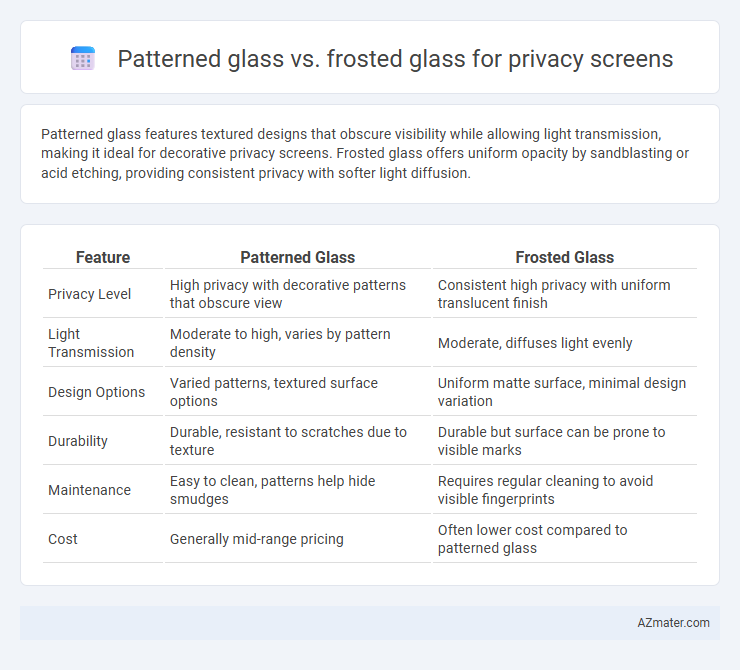Patterned glass features textured designs that obscure visibility while allowing light transmission, making it ideal for decorative privacy screens. Frosted glass offers uniform opacity by sandblasting or acid etching, providing consistent privacy with softer light diffusion.
Table of Comparison
| Feature | Patterned Glass | Frosted Glass |
|---|---|---|
| Privacy Level | High privacy with decorative patterns that obscure view | Consistent high privacy with uniform translucent finish |
| Light Transmission | Moderate to high, varies by pattern density | Moderate, diffuses light evenly |
| Design Options | Varied patterns, textured surface options | Uniform matte surface, minimal design variation |
| Durability | Durable, resistant to scratches due to texture | Durable but surface can be prone to visible marks |
| Maintenance | Easy to clean, patterns help hide smudges | Requires regular cleaning to avoid visible fingerprints |
| Cost | Generally mid-range pricing | Often lower cost compared to patterned glass |
Introduction to Privacy Glass Solutions
Patterned glass features textured designs that obscure visibility while allowing natural light to pass through, making it ideal for enhancing privacy without sacrificing brightness. Frosted glass, created by sandblasting or acid etching, offers a uniform translucent surface that effectively diffuses light and prevents clear sightlines. Both options serve as stylish and functional privacy glass solutions suitable for residential and commercial interiors.
What is Patterned Glass?
Patterned glass features embossed or textured surfaces that create unique visual effects and distort images for enhanced privacy while allowing natural light to pass through. Common patterns include rain, reed, and hammered textures, which offer varying degrees of obscurity and aesthetic appeal. This type of glass is often used in office partitions, bathroom windows, and decorative screens to maintain privacy without sacrificing illumination.
What is Frosted Glass?
Frosted glass is created by sandblasting or acid-etching clear glass, producing a translucent surface that diffuses light while obscuring visibility, making it ideal for privacy screens. Unlike patterned glass, which has decorative textures or designs, frosted glass offers a uniform, matte finish that maintains natural light flow without compromising confidentiality. This makes frosted glass especially effective in office partitions, bathroom windows, and privacy doors where both privacy and light transmission are essential.
Privacy Levels: Patterned vs Frosted Glass
Patterned glass offers moderate privacy by obscuring direct visibility through its textured designs while allowing light to pass through, making it suitable for areas requiring partial privacy. Frosted glass provides higher privacy levels by diffusing light and blocking detailed views, effectively preventing clear visibility from both sides. Selecting between patterned and frosted glass depends on the desired balance between natural light transmission and visual privacy for spaces like bathrooms, offices, or conference rooms.
Light Transmission Comparison
Patterned glass typically offers higher light transmission rates ranging from 60% to 80%, allowing more natural light while providing moderate privacy. Frosted glass usually reduces light transmission to about 30% to 50%, diffusing light extensively to enhance privacy but resulting in a dimmer environment. Both types balance between visibility and illumination, with patterned glass favoring brightness and frosted glass prioritizing obscurity.
Aesthetic Differences and Design Options
Patterned glass offers a wide range of intricate designs such as floral, geometric, or abstract patterns that add a decorative element while maintaining partial visibility, making it ideal for spaces that require both privacy and style. Frosted glass provides a smooth, opaque finish that diffuses light evenly, creating a minimalist and modern aesthetic suited for sleek, contemporary interiors. Both options enhance privacy effectively but differ in texture and visual impact, allowing designers to select based on the desired ambiance and design theme.
Durability and Maintenance
Patterned glass offers enhanced durability due to its textured surface that resists scratches and fingerprints, making it ideal for high-traffic areas requiring low maintenance. Frosted glass, created through acid etching or sandblasting, provides a smooth, matte finish that may show wear more easily and require more careful cleaning to avoid damage. Both types effectively ensure privacy, but patterned glass generally outperforms frosted glass in longevity and ease of upkeep.
Applications in Home and Office Settings
Patterned glass offers decorative privacy with customizable textures ideal for living room partitions and bathroom windows, enhancing aesthetic appeal while diffusing light. Frosted glass provides consistent opacity, making it suitable for office conference rooms and workstation dividers where visual privacy and glare reduction are essential. Both options improve privacy without sacrificing natural light, but patterned glass leans toward decorative use, whereas frosted glass prioritizes functional privacy.
Cost and Installation Factors
Patterned glass typically costs more than frosted glass due to its intricate designs and manufacturing process, while frosted glass offers a more budget-friendly option with simpler production. Installation of patterned glass can require specialized handling and expertise because of its detailed textures, potentially increasing labor expenses, whereas frosted glass is easier and quicker to install, reducing overall installation time and cost. Both types enhance privacy effectively, but frosted glass generally provides a more cost-efficient and straightforward solution for privacy screens.
Choosing the Best Glass for Privacy Screens
Patterned glass offers a variety of textures and designs that obscure visibility while adding decorative appeal, making it ideal for privacy screens in spaces requiring both function and style. Frosted glass provides a uniform, translucent surface that maximizes light diffusion and privacy without compromising brightness, suitable for office partitions and bathroom enclosures. Selecting the best glass for privacy screens depends on balancing aesthetic preferences, light requirements, and the desired level of obscurity.

Infographic: Patterned glass vs Frosted glass for Privacy screen
 azmater.com
azmater.com